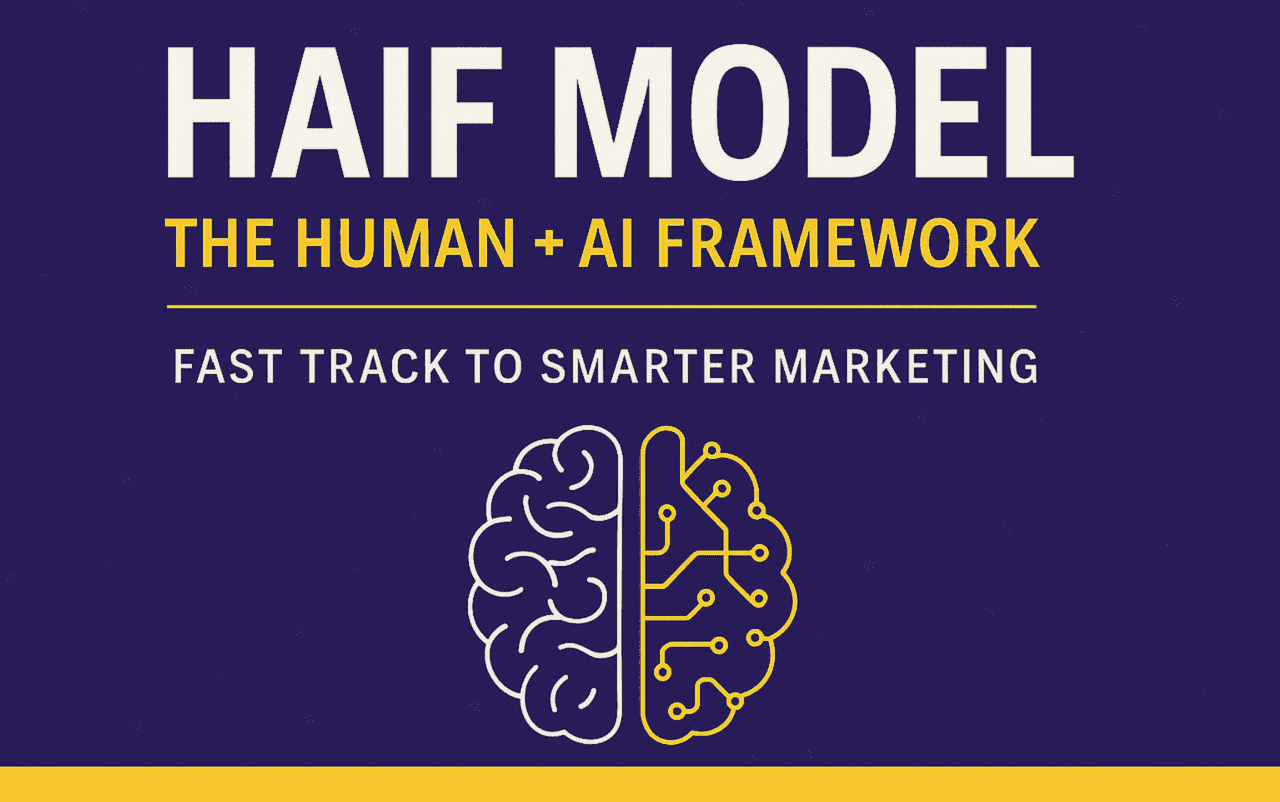Artificial Intelligence is changing how marketing works. Every channel, every process, and every discipline now has some layer of AI woven into it. Yet many businesses still struggle to understand how to use it effectively.
The issue isn’t access to tools. It’s the lack of structure. The HAIF Model (Human + AI Framework) was built to solve that problem.

It provides a clear framework for aligning human strategy with AI execution, helping marketing teams evolve without losing their voice or control.
HAIF transforms curiosity about AI into clarity and purpose.
It brings the human and machine sides of marketing together under one system designed for real-world execution.
The Origin and Philosophy of HAIF
The Human + AI Framework grew out of two decades of hands-on experience leading digital marketing programs through constant change.
Early in the 2000s, marketing was built on intuition, keyword data, and creative experimentation.
Over time, automation, algorithms, and analytics took center stage.
Then AI accelerated everything.
The gap between what marketers wanted to achieve and what they could manage manually grew wider every year.
I created HAIF as a practical roadmap for closing that gap.
Too many teams tried to force AI into existing workflows without understanding the role it should play.
They automated tasks but not strategy. They used AI to produce content faster but failed to guide quality or brand consistency.
HAIF redefines how AI fits into marketing by putting humans in charge again.
The philosophy is simple: AI should enable better decisions, not make them for you.
I built the model through direct observation, working with teams that adopted AI successfully and those that struggled.
It reflects what actually works when humans and machines collaborate toward measurable outcomes.
Why HAIF Matters
AI offers speed, scale, and precision. Humans provide vision, empathy, and creativity.
When both sides work in sync, marketing becomes more effective and adaptable.
But when they don’t, even the most advanced technology can add confusion instead of bringing in more clarity.
HAIF matters because it formalizes that balance. It gives structure to how AI operates within marketing: where to use it, when to use it, and how to measure its impact.
HAIF helps businesses:
- Scale output without losing authenticity
- Improve decision-making through data-informed insight
- Increase efficiency without compromising control
- Maintain brand credibility while embracing automation
The result is a marketing system that evolves intelligently.
Instead of chasing the next trend, HAIF helps teams build capability that endures.
Common AI Missteps that HAIF Helps Address
AI creates opportunity, but without direction it can quickly create chaos.
Teams that dive in without an overarching strategic framework often find themselves overwhelmed by tools and underwhelmed by results.
They write prompts with no standards, publish AI content without review, and hope for traffic that never arrives.
One team might use ChatGPT for blog content, another for reports, and another for ad copy. And in doing so, each very well may produce inconsistent tone and incomplete messaging.
Another common mistake is outsourcing too much judgment to automation. Thinks of a scenario where marketers accept AI outputs at face value, assuming that data equals truth and accuracy.
They forget that models reflect patterns, not meaning. That leads to generic campaigns, repetitive content, and loss of audience trust.
HAIF was built to prevent these problems. It defines where human oversight stays in charge, and how AI should complement that oversight.
It restores consistency, quality, and accountability.
The difference between random automation and responsible AI integration is process.
HAIF is that process.
The Seven Phases of HAIF
The Human + AI Framework organizes marketing transformation into seven connected Phases, each guiding a specific stage of adoption.
Together they form a system that blends innovation with structure.
1. Foundations of HAIF and AI Marketing
Every framework begins with shared understanding.
This phase establishes the foundation: the mindset, vocabulary, and operational clarity needed before integrating AI.
It provides teams an opportunity to align around:
- What AI means in their environment
- How it supports existing marketing priorities
They assess current maturity levels across data, workflows, and governance.
The purpose of this phase is to help teams identify where human input drives the most value and where automation can relieve friction.
The foundation isn’t about tools. It’s about readiness.
When that foundation is strong, AI adoption becomes strategic rather than reactive.
When teams get this stage right, they can build a culture of learning and experimentation that lasts.
2. AI Readiness and Setup
Once the foundation is in place, HAIF moves to readiness and setup (the phase where ideas become operational).
Teams audit their systems, content repositories, and processes to identify what can connect to AI safely and effectively.
They clean up redundant workflows, clarify data ownership, and map where automation can drive efficiency.
Readiness also involves people. It defines who will own AI strategy, review content, manage compliance, and measure results.
Without that structure, there will be no accountability built into the process from the start.
This phase ensures your foundation has direction. It turns strategy into motion, setting the stage for real transformation.
When companies reach true readiness, AI can become an integrated teammate rather than an isolated tool.
3. AI-Optimized Messaging and Content Strategy
Marketing still begins with story. AI doesn’t change that. It amplifies it.
In this phase, HAIF helps teams combine human insight with machine speed to create scalable, high-quality content.
Real people lead strategy, positioning, and emotional tone. AI accelerates research, ideation, and drafting.
Teams apply structured content models that improve consistency and discoverability.
Then, they can use AI to test new angles, refresh old material, and analyze audience response.
The result is a brand voice that remains human but operates with AI-level precision.
When messaging and AI work in harmony, every piece of content serves both creativity and visibility.
4. AI-Driven Marketing Execution
Execution is where AI delivers the most visible impact.
Here, teams learn how to use AI for campaign delivery across paid, organic, and owned channels.
Automation streamlines targeting, creative testing, and reporting, while humans stay focused on strategy and interpretation.
HAIF defines clear boundaries between what AI does and what humans decide. AI handles speed and scale; humans handle context and meaning.
Marketing execution under HAIF moves faster, costs less, and adapts continuously. It feels organized rather than reactive.
When done well, AI execution feels invisible to the audience…everything works seamlessly, and the brand experience stays consistent.
5. Measuring Performance of AI Initiatives
Without measurement, AI is just yet another source of activity.
This phase brings rigor to performance analysis by connecting AI work to measurable business results.
Teams establish baseline data, track progress, and adjust models based on what they learn.
HAIF measurement should focus on outcomes, not just output. Be sure it tracks improvements in speed, accuracy (an underappreciated need), ROI, and engagement quality.
Performance dashboards can then turn AI data into actionable intelligence.
Always ensure that reviews are scheduled and planned on a regular basis, but not spontaneous or random.
And of course, every insight needs to feed back into strategy and execution.
When teams commit to measurement, AI stops being a buzzword and becomes an investment.
6. AI Ethics and Responsible Implementation
AI can only create trust when it operates transparently.
The ethics section of HAIF ensures every action taken by AI aligns with human values and brand standards.
Teams define all of the rules for fact-checking, privacy, copyright, and disclosure. They are responsible for reviewing data sources as well as outputs to confirm accuracy and fairness.
Ethical AI isn’t about fear. It’s about credibility.
Brands that adopt AI responsibly stand to build long-term trust with audiences and regulators alike.
This section reminds marketers that doing things right is just as important as doing them rapidly.
When companies follow ethical standards, they not only protect their reputation but strengthen their differentiation in the market.
7. Implementing HAIF in Your Business
The final section focuses on making HAIF operational.
To properly integrate AI into your real world processes, it should look something like this:
- Teams apply the framework to real campaigns, workflows, and daily collaboration
- Leadership sets expectations and accountability across departments
- AI becomes part of every planning meeting, creative review, and performance discussion, not an afterthought
Implementation isn’t a one-time event. It needs to evolve as tools and markets evolve.
HAIF provides a tool agnostic and repeatable model that can scale as your organization grows.
When a company fully implements HAIF, the framework should become part of its culture.
AI adoption can then cease being merely a project, and become a real competitive advantage.
HAIF in Practice
HAIF comes alive inside marketing organizations that commit to learning and iteration.
A B2B software company might start by mapping how AI supports content creation and lead scoring. Their team can then refine prompts, test models, and track improvement week by week. After a quarter, they can expect to see measurable gains in efficiency and message consistency.
An e-commerce brand might integrate HAIF into paid advertising, using AI for audience segmentation and bid adjustments while human managers focus on creative and storytelling. They expect to save time on repetitive tasks and gain sharper insight into what drives conversions.
In both cases, the model brings structure to innovation.
HAIF offers marketing leaders the confidence to know that AI works with them, not around them.
The Human + AI Balance
The most powerful marketing execution won’t come from machines or humans alone. In a silo, neither can match the power of Human + AI, together:
- Humans set direction, tone, and purpose
- AI accelerates execution and learning
When both sides operate together, strategy becomes more dynamic, and outcomes compound over time.
This is the heart of HAIF: a relationship of mutual dependence where each side amplifies the other.
Organizations that embrace this balance will stay adaptable, ethical, and consistently ahead of change as this AI revolution continues to grow over time.
How Return On Now Applies HAIF
HAIF shapes every engagement we deliver:
- Austin SEO Services apply it to content optimization and technical precision
- AI-Driven Discoverability uses it to increase brand visibility within search and generative engines (LLMs), a key to our AEO and GEO methodologies
- AI-Enabled Advertising applies it to paid media efficiency and message control
HAIF is the blueprint behind our consulting and execution.
It’s how we ensure strategy stays human while results scale through AI.
The Long-Term Vision
The HAIF Model is more than a framework. It’s a mindset for the future of marketing.
AI will keep advancing, but the brands that thrive will be those that understand the value of balance.
They’ll use AI to enhance people, not replace them. They’ll build workflows that respect both intelligence and integrity.
HAIF was built to guide that evolution. It gives structure to progress and ensures that as technology grows more capable, your team can grow more empowered.
The future belongs to those who combine the best of both.
Ready to Learn More?
Discover how HAIF can transform how your team operates and communicates.
Contact Us to explore how to apply the Human + AI Framework inside your organization.
Frequently Asked Questions (FAQ) About HAIF
Want the Full HAIF Course and Toolset?
The full course includes 25 modules and 30 accompanying, actionable tools so you can adopt HAIF in your own organization, at your own pace.
Purchase it today on Gumroad at https://returnonnow.gumroad.com/l/haif-guide
About the Author
Tommy Landry is the founder of Return On Now, with over 25 years of experience helping businesses improve online visibility. His expertise spans Search Engine Optimization (SEO), Answer Engine Optimization (AEO), and Generative Engine Optimization (GEO), with a focus on combining Human + AI strategies to deliver measurable growth via a range of marketing and digital touchpoints. Tommy has advised organizations ranging from startups to global enterprises, always with an eye toward smarter discoverability in the evolving search landscape.

